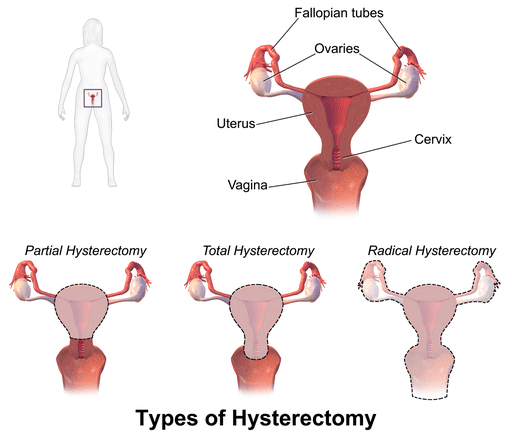What is a hysterectomy?
A hysterectomy is the removal of the uterus with the cervix (total hysterectomy) or without the cervix (subtotal hysterectomy). This can be done abdominally or vaginally, depending on the size of the uterus and other factors. Your ovaries may or may not need to be removed at the same time, depending on your medical condition.
If your hysterectomy is to be done abdominally, this will be performed under general anaesthesia by:
- Laparoscopy (keyhole): this surgery usually involves a 1cm cut in your umbilicus and three to four 0.5cm cuts in your abdomen. A laparoscope (camera) is inserted through your umbilicus, and the pelvis inspected. The uterus is removed from its attachments to the body and delivered through the vagina (much like delivering a baby).
- Laparotomy (open): this surgery usually involves either a horizontal (similar to that of a caesarean section) or vertical abdominal incision, and is typically done if the uterus is too large for laparoscopy to be performed.
Risks of hysterectomy include:
Common (affecting 1-5% of patients):
- Persistent pain and bruising around the incision
- Abdominal distension and shoulder tip pain, particularly after laparoscopy
- Adhesions (scar tissue) which may form within the pelvis and around the site of surgery
- Excessive bleeding requiring blood transfusion during or after surgery, or possibly a return to the operating theatre
- Anaemia due to blood loss
- Difficulty or delay with urination or with bowel movements in the initial recovery period
- Wound infection, delayed healing or keloid scar formation
Uncommon (affecting 0.1-1% of patients):
- Damage to surrounding organs such as bladder, bowel, ureters, blood vessels or nerves
- Infection
- Deep venous thrombosis (blood clot in the leg) or pulmonary embolism (blood clot in the lung)
- Possible early menopausal symptoms
Rare (affecting <0.1% of patients):
- Serious adverse reactions to general anaesthesia, including cardiorespiratory complications
- Admission to the intensive care unit for monitoring should the operation be of prolonged duration or result in complications
- Death: the risk is approximately less than 3-8 in 100,000
Photo credit: BruceBlaus / Wikimedia Commons
